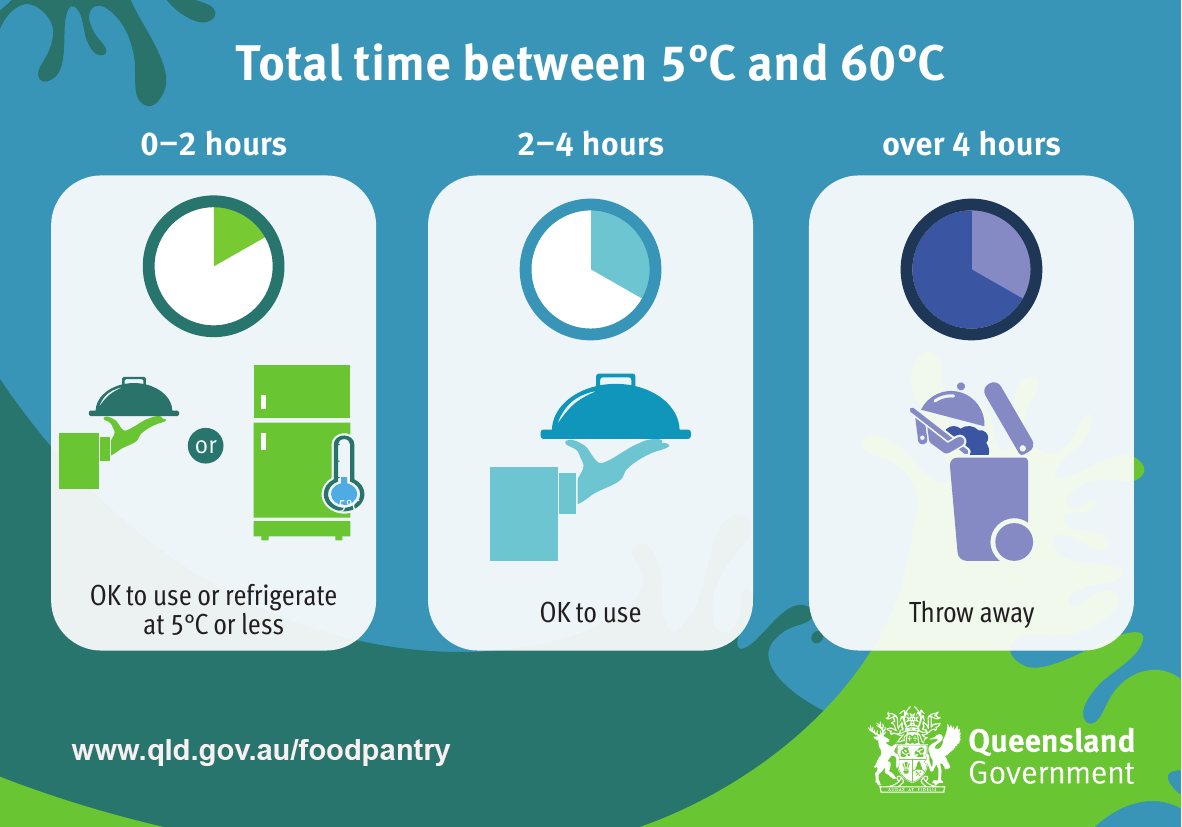Temperature control
Temperature control and monitoring is usually the first thing people think of and do to keep food safe. Temperature control prevents the growth of food poisoning bacteria by either lowering or raising the temperature to a point where the bacteria either die or stop multiplying.
However, bacteria require certain environmental conditions for optimal growth. These are:
- temperature (between 5°C and 60°C – the temperature danger zone)
- time (bacteria double every twenty (20) minutes in the right conditions)
- pH (around 7 or neutral)
- water
- protein (food source).
By controlling, one or more of these elements, you can control bacterial growth. Water and pH are controlled in manufactured products such as tinned, pickled or dried foods. You can easily manage time and temperature of your food.
Time control for ready to eat potentially hazardous food
You are required to maintain the temperature of potentially hazardous food either at or below 5°C or at or above 60°C at all times, unless the food business can demonstrate that maintaining food at another temperature for a specific length of time will not adversely affect the microbiological safety of the food.
It is very difficult for most food businesses to scientifically demonstrate alternative time and temperature combinations to ensure safe food. Safe Food Australia: A guide to the food safety standards provides advice to food businesses on the use of time as a control for potentially hazardous foods through the 4-hour/2-hour guide.
As a general rule, the total time that a ready-to-eat potentially hazardous food can be at temperatures between 5°C and 60°C is 4 hours. After this time the food must be discarded (thrown away). The total time is the sum of the time the food is at temperatures between 5°C and 60°C after it has been cooked or otherwise processed to make it safe. For example, if raw meat is cooked, count the time the food is at temperatures between 5°C and 60°C after it is cooked.
It is safe for potentially hazardous food to be between 5°C and 60°C for a limited time because, as discussed earlier, food poisoning bacteria need time to grow to unsafe levels.
The ‘2 hour/4 hour guide’ is summarised below.

If you wish to maintain potentially hazardous food between the temperatures of 5°C and 60°C for time periods longer than the 2 hours and 4 hours specified above, you will need to be able to demonstrate that the extension in time will not compromise the safety of the food.
Time control for cooked and cooled potentially hazardous foods
when cooling potentially hazardous food that has been cooked, you must cool the food:
- from 60°C to 21°C within 2 hours
- from 21°C to 5°C within a further 4 hours.
In order to cool food in these timeframes, you may need to alter the way you cool foods. Some examples may be:
- divide large volumes of cooked foods into smaller containers
- cut or divide large roasts into smaller portions
- allow plenty of space between cooling items to allow circulation of cold air.
Time control for food that has been cooked by another business
If you wish to use the 2 hour/4 hour guide for potentially hazardous food you have not cooked or otherwise processed to ensure its safety, you will need to know the temperature history of the food.
You need to know whether, following the cooking or other process step, the food spent any time at a temperature between 5°C and 60°C. If any of the available time has been ‘used up’ before you receive the food, this time must be counted. If you do not know the temperature history of the food and are not able to obtain this information, you cannot use time to control the growth of foodborne pathogens and must keep the food at or below 5°C or at or above 60°C.
Records
Keep the following records when you are controlling the temperature of food:


